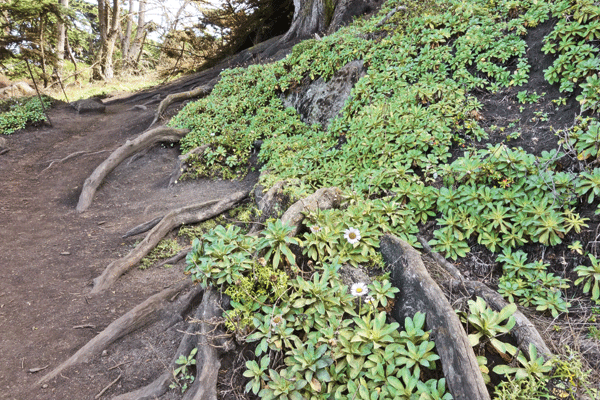
Each year I wait for them in my garden and so do the robins, varied thrush, jays, spotted towhees, grosbeaks and band-tailed pigeons. The fruit of sambucus mexicana, a California native plant, is relished by an incredible number of songbirds. The creamy flower clusters in the spring are a favorite of bees and other beneficial insects. My Western Elderberry grows tall and gangly in the shade of a California bay tree, shorter and more compact in the sun. Their exuberance for life makes me happy just to watch them provide for so many other species.
We’ve all driven down Highway 1 past the strawberry fields and seen the wetlands at high tide as their many fingers reach far up into the Watsonville area. At low tide the Harkins Slough is visible off to the west, grasses blowing gently in the wind. Struve Slough passes under Highway 1 also, but most of it is hidden. The Watsonville sloughs wind around farms, fields and low hills, not visible from the highway.
California has lost more than 90 percent of its wetlands and the Watsonville sloughs are one of the largest remaining freshwater marshlands in the state’s coastal zone. It provides a crucial resting place for many species of migrating birds. This area covers about 800 acres adjacent to the city of Watsonville. The slough system has six interlinked freshwater sloughs fed by the waters of the Pajaro Valley watershed.
Many of the plants native to the wetlands will be available at a sale to fund educational programs put on by the organization Watsonville Wetlands Watch whose mission is to protect and restore the wetlands while educating the community.
The Native Plant and Backyard Festival will take place from 10 a.m. to 2 p.m. Saturday, September 28 at the Fitz Wetlands Educational Resource Center, 500 Harkins Slough Road in Watsonville, just behind Pajaro Valley High School.
It will be their second annual plant sale. Plants beneficial for backyard habitat gardens will be featured; many which were grown in their own greenhouses. Natives like buckwheat or eriogonum, as they are called, are a mainstay of the slough ecosystem as well as our chaparral areas and several varieties will be offered for sale.
One of my favorite eriogonums is the Red Buckwheat. In addition to attracting beneficial insects, the flowers can be dried and used in arrangements. The roots are deep and will hold the soil and bring up subsoil nutrients to the surface. They are very drought tolerant. In the weeks to come the buckwheat’s long nodding flower heads will produce a huge bounty of weed favored by migrating songbirds and water birds, some of which will spend the winter here.
Coast asters will also be available for sale and make a nice addition to any garden. They provide flower color in the fall and combine well with other perennials and grasses such as yarrow and Idaho fescue. They colonize easily and help stabilize slopes and banks and can also be used as an understory plant. They are very drought tolerant. Native grasses will also be for sale as well as plants of the coastal prairie and wildflowers.
Besides the native plant sale, Watsonville Wetlands Watch will have workshops with expert speakers, an Eco Kid Zone, food, a marimba band, a raffle, live animals and local wildlife displays. Free habitat consultations for your own backyard, demonstration habitats, a wetlands wildlife photography exhibit and a tour or their new greenhouse.
For more information about the sale and this wonderful organization visit www.watsonvillewetlandswatch.org
Your own backyard can make a difference for wildlife. Even a small plot of plants rich in nectar and pollen along with some water, rocks, stones and mulch can make your backyard come alive. Create your own backyard habitat by choosing the right native plants to attract butterflies, birds and other fauna and at the same time conserve water and help maintain the diversity of our animal population.
– Jan Nelson, a landscape designer and California certified nursery professional, will answer questions about gardening in the Santa Cruz Mountains. E-mail her at ja******@*ol.com, or visit www.jannelsonlandscapedesign.com to view past columns and pictures.












